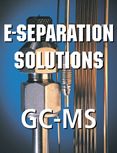Technology Forum: GC-MS
Gas chromatography may be a mature technique, but the need for it in the world of industry has never been greater. With environmental and petroleum-related issues dominating the social and political landscape, expertise in the area of GC-MS is in demand more than ever, making this month?s Tech Forum particularly topical. This month E-Separations Solutions' Technology Forum looks at the topic of GC-MS and the trends and issues surrounding it. Joining us for this discussion are Daniel Pentek of PerkinElmer, Inc. and Hans-Joachim Huebschmann of Thermo Fisher Scientific, Inc.

Gas chromatography may be a mature technique, but the need for it in the world of industry has never been greater. With environmental and petroleum-related issues dominating the social and political landscape, expertise in the area of GC-MS is in demand more than ever, making this month's Tech Forum particularly topical.
This month, Chromatography Online's Technology Forum looks at the topic of GC-MS and the trends and issues surrounding it. Joining us for this discussion is Daniel Pentek of PerkinElmer, Inc., and Hans-Joachim Huebschmann of Thermo Fisher Scientific, Inc.
1. What trends do you see emerging in GC-MS?
Pentek: There is constant market pressure on all manufacturers regarding the expectation of ever lower prices, but with no loss of (or preferably, improved) analytical performance. At the same time, the typical operator's level of education and experience continues to decline, so GC-MS software must compensate by being easier to use and able to drive a system that is increasingly automated.One specific trend that we have noticed is the demand for application specific systems to address specific problems, such as melamine analysis in the consumer product testing area. This type of complete solution, with sample preparation instructions and predefined GC and MS method and data acquisition conditions, allows an inexperienced operator to produce reliable results and allows the technology to migrate into new markets.
Huebschmann:Laboratories continue to look for ways to use GC-MS technology to get more information about samples in less time. Coupling fast gas chromatography and even ultra-fast gas GC to mass spectrometers is a key way to get more samples through per hour. Pressures to reduce sample preparation steps to increase productivity and reduce costs require GC-MS systems that can stand up to samples that have not been subjected to the thorough clean-up steps traditionally used for GC-MS.Prices continue to fall for routine GC-MS instruments (i.e. nominal mass, single quadrupole) as the technique becomes more of a routine chromatography tool. However, legal requirements to provide highest reliability in data for export/import controls as required for food safety and other applications means that on the technology side, we see a resurgence of MS-MS, SRM, and H-SRM techniques with triple quadrupoles as a more common chromatography tool for doing trace level analyses. The need for mass accuracy is gaining attention as well.These trends mirror market demands for increased sensitivity, higher reliability, and the replacement of classical analog detectors with mass spectrometry, particularly in areas of pesticide analysis.
2. What is the future of GC-MS?
Pentek: We see both technology and market trends driving the future of GC-MS. From the technology perspective, some of the MS technologies that are more prevalent in the LC technology space (MS-MS, TOF, etc.) are slowly migrating into specific niches in GC-MS where their significantly higher cost can be justified. Similarly, GC technology continues to improve, with faster GC ovens and detectors that increase sample throughput. Front-end sample-handling technologies (headspace sampling, thermal desorption, purge and trap, etc.) continue to evolve to address ever-more complex sample matrices. Finally, automated data interpretation and reporting capabilities are becoming increasingly important to lessen the burden on the analyst.The market is driving all these facets of GC-MS development because it is demanding a better, complete, integrated solution. The market wants a common software platform that controls hardware from multiple vendors, automated sample preparation capability to address the future bottlenecks of sample throughput, and easier to use software, with automated data analysis and reporting capability.
Huebschmann:Single quadrupole mass spectrometers will become the "classical detector" for GC, while high resolution instruments will move into the routine area currently occupied primarily by these nominal resolution systems. GC-MS systems will move from being instruments to being routine analyzers. For example, there will be "pesticide analyzers" - smaller, cheaper, faster instruments that let users get from sample to answer in less time. Newer instruments will offer the ultimate in selectivity with high mass accuracy so that sensitivity in and of itself is no longer the key consideration in GC-MS. This expanded selectivity will still need to be combined with a broad dynamic range to be able to cover everything from trace levels to high concentrations of contaminants.
3. What is the GC-MS application area that you see growing the fastest?
Pentek: We continue to see growth in three primary areas: environmental applications, primarily water and air; quality analysis; consumer product safety testing, which has a much higher profile given all the product recalls of the past year; and petrochemical applications, driven by the global demand for, and consequently the price of, oil.
Huebschmann:Clearly, food and product safety are two application areas that are so often in the news today, and are growing applications for GC-MS as well as LC-MS as complementary techniques. As a subset of food safety, however, we can also see that food security - looking at food contaminated for intentional harm - is an area of concern. The screening for this type of contamination would have to be much broader in terms of looking for any poisonous compounds - metals, glass, toxins. The huge database of spectral fingerprints makes unknown identification - more libraries approaching 3000-4000 compounds - more challenging and requires a better ability to run screening methods. While GC-MS may not provide the tool for covering all of these potential hazards, it is a powerful tool for helping to protect food supplies from intentional efforts to strike a population via its food supply.
4. What obstacles stand in the way of GC-MS development?
Pentek: The rapid growth of LC-MS and the focus on life sciences has definitely slowed the development of GC-MS. There also appears to be a reluctance to explore new GC-MS technologies on the part of many GC-MS users, partly because many applications are regulatory driven, which can inhibit the adoption of new technologies. There aren't many users who are willing, or able, to push the envelope of GC-MS development.
Huebschmann:Today, GC-MS systems offer more sensitivity than we can practically use, but we run into limitations on selectivity when we run into chemical noise. It doesn?t matter how sensitive we make the instruments, we cannot penetrate this limitation until we provide additional selectivity using tools such as SRM, high resolution, and high mass accuracy. Bringing high resolution and high mass accuracy to a price point where these instruments can become more routinely used is a clear challenge.
5. What was the biggest accomplishment or news in 2007 for GC-MS?
Pentek: I would say the increased role of GC-MS in the assessment of product safety is probably the biggest news. It is proving to be an invaluable tool in the identification of potential endocrine disruptors in consumer products such as shampoos, or containers such as baby bottles. It has already emerged as the method of choice for the analysis of melamine in pet foods. These are just a few of the many examples that have allowed the technology to regain some of its luster and it has been a helpful reminder of just how powerful it can be. It also has allowed the technology to gain greater acceptance in some application areas and markets where, previously, it had lesser impact.
Huebschmann:We have seen the launch of a complete product range addressing GC-MS needs at every level of specificity and sensitivity. Workflow-oriented software that automates routine processes allows laboratories to easily take advantage of new technologies and sophisticated techniques. Reporting SRM, H-SRM, and MS-MS data in formats that are easy to understand is a key step toward making these techniques that offer greater selectivity more routine. These software packages and instrument systems focus not only on productivity but also provide compliance with international regulations for analysis and reporting.

Characterizing Plant Polysaccharides Using Size-Exclusion Chromatography
April 4th 2025With green chemistry becoming more standardized, Leena Pitkänen of Aalto University analyzed how useful size-exclusion chromatography (SEC) and asymmetric flow field-flow fractionation (AF4) could be in characterizing plant polysaccharides.
Investigating the Protective Effects of Frankincense Oil on Wound Healing with GC–MS
April 2nd 2025Frankincense essential oil is known for its anti-inflammatory, antioxidant, and therapeutic properties. A recent study investigated the protective effects of the oil in an excision wound model in rats, focusing on oxidative stress reduction, inflammatory cytokine modulation, and caspase-3 regulation; chemical composition of the oil was analyzed using gas chromatography–mass spectrometry (GC–MS).






